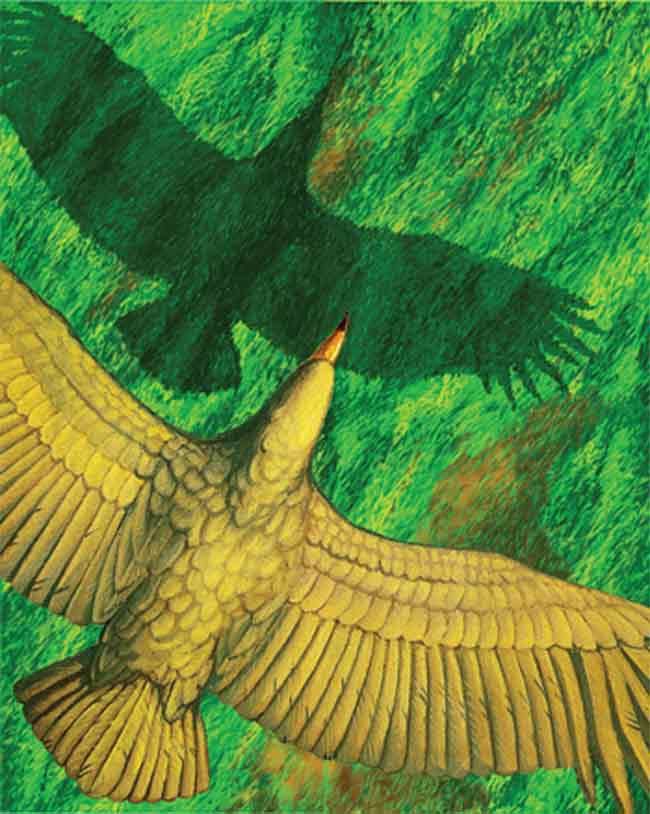How an Airplane-Sized Bird Replaced Its FeathersBy Jeanna Bryner, Senior Writer
posted: 16 June 2009 08:34 am ET
An extinct bird the size of a Cessna airplane and weighing as much as an average human was one of the largest birds to have ever flown the friendly skies.
Scientists have wondered how the bird, called
Argentavis magnificens, could balloon to such heft (more than 150 pounds, or 70 kg) and still replace its feathers during a molt. Now, new research reveals the bird, which lived 6 million years ago in the Miocene epoch, likely molted all of its feathers at once during a long fast.
The finding derives from a larger study that figures out a strange limiting factor to maximum body size in birds — the amount of time it takes to replace flight feathers.
Flight factors The link between molting and bird size may seem like a stretch. But without feathers, birds are basically grounded. Over time, bird feathers wear out due to exposure to the sun's harsh ultraviolet rays and from bacterial decomposition. The solution: Birds periodically shed and replace their coats.
Birds that depend on being airborne to snag food must employ one of a handful of strategies for replenishing their nine or 10 lengthy flight feathers without starving.
Small birds accomplish this by molting once or twice a year, during which time their flight feathers are replaced sequentially, taking about three weeks for each feather.
This process gets messy though for larger birds, which need longer feathers for flight. Feather length approximately doubles for each 10-fold increase in mass. Everything would be dandy if the speed of feather growth increased proportionately with this increase in weight. But it doesn’t.
For each 10-fold increase in mass, the time required to replace each feather increases by a factor of about 1.5, until 56 days are required to replace a single flight feather in a bird weighing 22 pounds (10 kg).
This relationship between feather growth and bird mass requires basic changes in the molt strategy as size increases, ultimately limiting the size of flying birds.
Replacing feathers Sievert Rohwer of the University of Washington's Burke Museum in Seattle and his colleagues looked at how feather growth rate and length varied with body mass for a range of birds. They specifically found that birds that molt all their flight feathers in one year can grow no larger than 6.6 pounds (3 kg), at least for birds that require flight to find food during their grounded stint.
(For instance, a Canada goose can weigh more than 10 pounds, or nearly 5 kg, but still replaces its flight feathers every year. The geese are flightless during this month-long molt, during which time they congregate at lakes and ponds that provide safe places to feed.)
Beyond that weight, birds employ one of several strategies, the researchers suggest. The big birds can: prolong the total molt to every two or even three years; simultaneously replace multiple feathers from different places in the feather sequence; and, for species that don't need flight to feed or escape enemies, such as ducks and geese, replace all feathers simultaneously.
Maximum mass The finding, published in a forthcoming issue of the journal PLoS Biology, could explain how birds exceed the weight limit defined by flight muscles.
"The maximum size of flying birds is determined by the power available from muscles and the power required for flight," Rohwer told LiveScience. "For sustained powered flight (flight entirely powered by flapping, not soaring), this maximum body size appears to be about 15 kg (33 pounds)."
He added, "But larger size can be achieved if soaring flight is possible, and if the time demands of flight feather replacement do not compete too much with reproduction." (Both feather replacement and breeding require oodles of energy and so birds probably wouldn't spend years replacing flight feathers if it means they couldn't reproduce.)
"This is why we speculate that the 70-kg Argentavis likely underwent simultaneous replacement of its flight feathers," Rohwer said.
During its molt, which is estimated to have taken 74 days, the bird likely survived on accumulated fat deposits much in the same way as emperor penguins do today.
 Illustration of the world's largest known flying bird (Argentavis magnificens) with a wingspan of about 23 feet, soaring over the plains of Argentina 6 million years ago.www.livescience.com/animals/090616-bird-size.html
Illustration of the world's largest known flying bird (Argentavis magnificens) with a wingspan of about 23 feet, soaring over the plains of Argentina 6 million years ago.www.livescience.com/animals/090616-bird-size.html